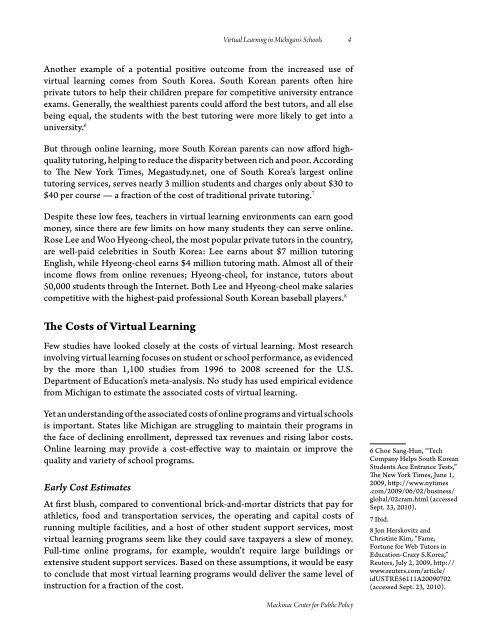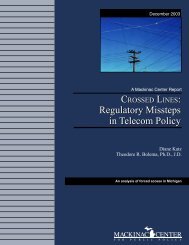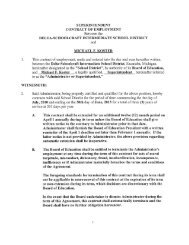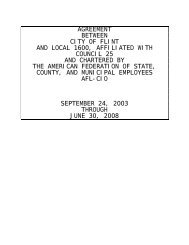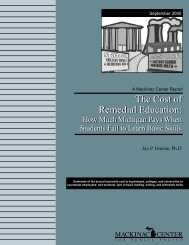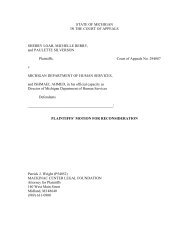<strong>Virtual</strong> Learning in <strong>Michigan</strong>’s Schools 4Another example of a potential positive outcome from the increased use ofvirtual learning comes from South Korea. South Korean parents often hireprivate tutors to help their children prepare for competitive university entranceexams. Generally, the wealthiest parents could afford the best tutors, and all elsebeing equal, the students with the best tutoring were more likely to get into auniversity. 6But through online learning, more South Korean parents can now afford highqualitytutoring, helping to reduce the disparity between rich and poor. Accordingto The New York Times, Megastudy.net, one of South Korea’s largest onlinetutoring services, serves nearly 3 million students and charges only about $30 to$40 per course — a fraction of the cost of traditional private tutoring. 7Despite these low fees, teachers in virtual learning environments can earn goodmoney, since there are few limits on how many students they can serve online.Rose Lee and Woo Hyeong-cheol, the most popular private tutors in the country,are well-paid celebrities in South Korea: Lee earns about $7 million tutoringEnglish, while Hyeong-cheol earns $4 million tutoring math. Almost all of theirincome flows from online revenues; Hyeong-cheol, for instance, tutors about50,000 students through the Internet. Both Lee and Hyeong-cheol make salariescompetitive with the highest-paid professional South Korean baseball players. 8The Costs of <strong>Virtual</strong> LearningFew studies have looked closely at the costs of virtual learning. Most researchinvolving virtual learning focuses on student or school performance, as evidenced<strong>by</strong> the more than 1,100 studies from 1996 to 2008 screened for the U.S.Department of Education’s meta-analysis. No study has used empirical evidencefrom <strong>Michigan</strong> to estimate the associated costs of virtual learning.Yet an understanding of the associated costs of online programs and virtual schoolsis important. States like <strong>Michigan</strong> are struggling to maintain their programs inthe face of declining enrollment, depressed tax revenues and rising labor costs.Online learning may provide a cost-effective way to maintain or improve thequality and variety of school programs.Early Cost EstimatesAt first blush, compared to conventional brick-and-mortar districts that pay forathletics, food and transportation services, the operating and capital costs ofrunning multiple facilities, and a host of other student support services, mostvirtual learning programs seem like they could save taxpayers a slew of money.Full-time online programs, for example, wouldn’t require large buildings orextensive student support services. Based on these assumptions, it would be easyto conclude that most virtual learning programs would deliver the same level ofinstruction for a fraction of the cost.6 Choe Sang-Hun, “TechCompany Helps South KoreanStudents Ace Entrance Tests,”The New York Times, June 1,2009, http://www.nytimes.com/2009/06/02/business/global/02cram.html (accessedSept. 23, 2010).7 Ibid.8 Jon Herskovitz andChristine Kim, “Fame,Fortune for Web Tutors inEducation-Crazy S.Korea,”Reuters, July 2, 2009, http://www.reuters.com/article/idUSTRE56111A20090702(accessed Sept. 23, 2010).Mackinac Center for Public Policy
<strong>Virtual</strong> Learning in <strong>Michigan</strong>’s Schools 5Some early attempts to gauge the costs of virtual learning, however, suggestedthat the price for online learning would be fairly similar to that of brick-andmortareducation. In 2006, Augenblick, Palaich and Associates Inc., a privateeducation research and consulting firm, put together a panel of school officialsand experts to estimate the costs of virtual schools. A follow-up report, preparedfor the BellSouth Foundation (now the AT&T Foundation), the charitablearm of the former telecommunications company, outlined the cost estimatesidentified <strong>by</strong> these experts, including those associated with instructionalpersonnel, management, course development, technology personnel,equipment and networking, and facilities acquisition and maintenance. In theend, the study’s experts estimated that a full-time virtual program’s operatingcosts were likely to be between $7,200 and $8,300 per full-time student afterinitial start-up costs of $1.6 million were met. 9The $7,200 to $8,300 estimated per-pupil operating cost for virtual programs waslower than the U.S. average per-pupil operating cost of $9,145 in 2005-2006 forconventional public schools. Nevertheless, the $8,300 upper estimate was higherthan the average per-pupil operating expenditures in 18 states. 10 APA ultimatelyconcluded that excluding transportation and capital expenses, “The operatingcosts of online programs are about the same as the operating costs of a regularbrick-and-mortar school.” 11In the same year, the Southern Regional Education Board, a nonprofitorganization collectively led <strong>by</strong> governors from 16 Southern states, developeda cost-estimating formula for state virtual schools, such as Florida <strong>Virtual</strong>School, that offer supplemental courses to a school’s existing curricula. Theformula took into consideration the fact that these virtual schools do not needto invest in a large physical plant to host students and can forgo the costs oftransportation, food services, libraries, athletic facilities and other itemsassociated with conventional brick-and-mortar schools that grant diplomas.However, virtual schools do bear higher costs for such things as computers,software, telecommunication services, technical support and employeetraining. In the end, the SREB projected initial per-pupil costs for virtualschools similar to those of brick-and-mortar schools, although it did suggestthat virtual schools could save taxpayers money over time. 12Early analyses of the costs of online programs in <strong>Michigan</strong> seemed to confirmthe findings of these two 2006 studies. Dansville Schools, a small district justsoutheast of the Lansing, began offering students online courses in 1999 througha private company in Massachusetts named <strong>Virtual</strong> High School. At first, the feesfor the virtual classes were entirely subsidized <strong>by</strong> a U.S. Department of EducationTechnology Innovation Challenge Grant, but once <strong>Virtual</strong> High School had tostart charging Dansville Schools fees for the courses, the district realized no fiscalbenefits from the program. 139 Amy Berk Anderson, JohnAugenblick, and Dale DeCesare,“Costs and Funding of <strong>Virtual</strong>Schools” (APA Consulting,2006), 12, http://www.inacol.org/research/docs/Costs&Funding.pdf (accessedJan. 11, 2011).10 “Table 184: Total andCurrent Expenditures Per Pupilin Fall Enrollment in PublicElementary and SecondaryEducation, <strong>by</strong> Function andState or Jurisdiction: 2005-06,”(National Center for EducationStatistics, 2009), http://nces.ed.gov/programs/digest/d09/tables/dt09_184.asp.11 Anderson, Augenblick, andDeCesare, “Costs and Fundingof <strong>Virtual</strong> Schools” (APAConsulting, 2006), 4-5, http://www.inacol.org/research/docs/Costs&Funding.pdf (accessedJan. 11, 2011).12 “Cost Guidelines for State<strong>Virtual</strong> Schools” (SouthernRegional Education Board,2006), 4-10, http://publications.sreb.org/2006/06T03_<strong>Virtual</strong>_School_Costs.pdf (accessedJan. 24, 2011).13 Brett Schaeffer, “<strong>Virtual</strong>savings? Online courses bringbetter access but little impacton the bottom line,” SchoolAdministrator (2004)goo.gl/Bwa0c (accessedJan. 9, 2011).Mackinac Center for Public Policy


